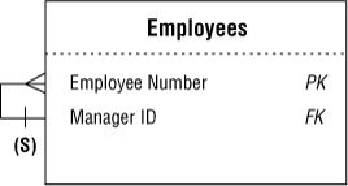Database Reference
In-Depth Information
Iftheemployeewhoserecordyouwanttodeleteisamanager,the
M
ANAGER
ID must be deleted from the record of every employee
he currently manages. (Use a
Nullify
rule.)
If the employee whose record you want to delete is a manager,
the M
ANAGER
ID must be reset to the senior manager's employee
number in the record of every employee he currently manages.
(Use a
Set Default
rule.)
Note
The Cascade rule is notably absent from this example because it doesn't apply to
the relationship at all; youdon'twant tofire employees just because their manager
is leaving the organization. This rule is still a viable option in some instances, so
do keep it in mind when you're establishing deletion rules for other self-referen-
cing relationships.
Say that you received the last reply in the preceding list and have determined that you're
going to use a Set Default deletion rule for the relationship. You now complete the process
by designating the rule on the relationship diagram.
Figure 10.58
shows the results of your
work.
Figure 10.58. Designating a Set Default deletion rule for the EMPLOYEES table
self-referencing relationship
Identifying the Type of Participation for Each Table
When you establish a relationship between a pair of tables, each table participates in a par-
ticular manner. The
type of participation
you assign to a given table determines whether a
record must exist in that table before you can enter records into the related table. There are
two types of participation.





